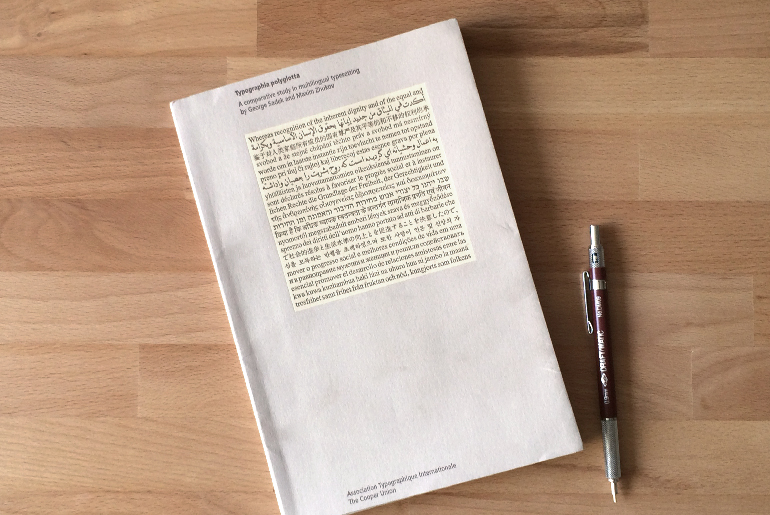“In the interest of communicating effectively and well, we are pleased to present Typographia Polyglotta. This book is a tool to help those who want to set type in different script and language forms to do it with greater ease. It is also a device for imagining: consider how much we can do with a laptop with a polyglot set of fonts on it, safe in the knowledge that the expression of our ideas and visions can reach anyone at any time”
When I was attending TypeCon14, I came across this small book called Typographia Polyglotta by George Sadek and Maxim Zhukov. It was undergoing the silent auction that was organized as part of the conference. Too bad, I couldn't win the bid, but I ordered it right after I got back home. The first edition of this book was published in 1991. It was a research project of the Herb Lubalin Study Center of Design and Typography at Cooper Union. The study is basically a comparative study in multilingual typesetting. The first edition of this book was concieved and esigned by George Sadek, and Frank Stanton. The book was republished by AtypI in 1997.
The authors basically took a sample text from the preamble to the Universal Declaration of Human Rights which is originally in English, and used its official translation to compare and contrast the typesetting between 22 different languages: English, Arabic, Chinese, Czech, Dutch, Esperanto, Farsi, Finnish, French, German, Hebrew, Hindi, Hungarian, Italian, Japanese, Korean, Portuguese, Russian, Spanish, Swahili, and Swedish. On the spread, you would see that passage typesetting on right side, and informational page about the language characteristics, and its typesetting on the left page.
I learned quite a bit from this read. First, At least for me, I think that it made me sure that learning by comparison is a good approach. In addition, I learned that the system of the language typesetting could affect the color/texture of the text a lot. Moreover, It was mentioned in the book that if someone is working on a bilingual design, its always better to start designing with the the language that has less fonts resources. I also learned that If we get the same text in English and translate it into Arabic, chances are that the text in Arabic will be relatively a bit shorter than the English.
This is too personal, but I always loved the Italian language, and I think that its the most beautiful spoken language. The following quote from the book made my day:
“Our experiment proves Italian to be indisputably the ‘best-looking’ language of all those that were tested using latin script.”
After reading this small book, I felt that there is a connection between this project, and Google Noto Fonts, which I will do further research on it in a later stage.

